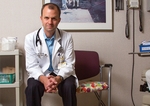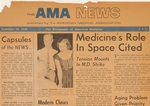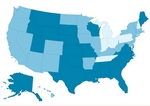government
What do 50.7 million uninsured mean to physicians?
■ At many practices, the economy has forced doctors to make stark choices as their patients find it harder to pay for care.
By Doug Trapp — Posted Sept. 27, 2010
- WITH THIS STORY:
- » No job, no health plan
- » Who are the uninsured?
- » Related content
Washington -- As the number of uninsured Americans spiked in 2009, physicians began offering new payment options, networking with other doctors to boost referrals, and accepting more Medicaid and uninsured patients. Doctors say they're spending more time helping patients who can't afford prescriptions, tests and other needed care.
The uninsured population reached 50.7 million in 2009, according to Census Bureau estimates released Sept. 16 -- the largest number since 1987, when the Census began its current method of estimating the uninsured.
The 9.4% increase from 2008 numbers was driven largely by a sharp decline in employer-sponsored coverage due to the recession. In January 2008, the national unemployment rate was 5%; the rate doubled to nearly 10% by the end of 2009. Also, 2009 was the first year the Census recorded a drop in the number of insured: from 255.1 million in 2008 to 253.6 million in 2009.
Medicaid enrollment increased by 12% between 2008 and 2009, reaching 47.8 million people. The percentage of Americans living in poverty increased from 13.2% to 14.3% -- the highest rate since 1994.
The effects of the rising number of uninsured are being felt in physician practices, in particular smaller ones that have seen their patient mix change, even if their patients haven't. "There's no doubt about it," said Tad Fisher, executive vice president of the Florida Academy of Family Physicians.
Even if physician practices aren't struggling, their patients probably are, said Yul Ejnes, MD, chair-elect of the Board of Regents of the American College of Physicians. "We're seeing more patients who call to cancel appointments or who aren't able to fill prescriptions," said Dr. Ejnes, an internist in Cranston, R.I.
Reluctant patients
The economy's effect on her patients has forced Amalia Pineres, MD, a family physician in Payson, Ariz., to make difficult choices.
Dr. Pineres said she runs a lean solo practice and can't afford to take on debt. However, Dr. Pineres also accepts more uninsured and Medicaid patients than she used to at her office, which is in a rural community about 90 miles northeast of Phoenix and home to the late Western author Zane Grey. She's also a board member of the Arizona Medical Assn.
The housing boom drove the local economy, Dr. Pineres said. Payson saw hundreds of new housing permits a year. That has dropped to a few dozen annually.
"All of the contractors in town are basically down to a standstill," Dr. Pineres said.
Some of Dr. Pineres' patients lost their private insurance and enrolled in Medicaid. Others lost their health coverage entirely. "I don't see the young patients who used to come in routinely," she said.
Dr. Pineres didn't plan on accepting uninsured patients when she opened her practice five years ago, but about 5% of her patients lost their coverage and still needed her care.
"You have to make exceptions. You've got to help people," she said.
Some patients are reluctant to schedule an office visit because of the potential cost. They fall out of touch for a year, two years or more.
"Their response is, 'I'm healthy, I don't need to see you.' But they don't even know if they're healthy," Dr. Pineres said.
She also is checking in on patients by phone more often, even if they didn't seem to need follow-up care. "So that at least I can document it in the chart."
In one instance, the phone call got a patient who had put off a checkup to come in and get a growth on her nose examined. The growth turned out to be a small basal cell cancer.
Less expensive care
Edward G. Jankowski, MD, a solo otolaryngologist, is seeing 10 to 20 fewer patients a week than the 75 to 80 patients a week who visited him a year or two ago.
His offices are in Grosse Pointe Woods, Mich., an affluent suburb whose population has declined as the fortunes of neighboring Detroit have suffered. Detroit-area unemployment was 15.1% in July, compared with 13.1% statewide and 9.6% nationally, according to the Bureau of Labor Statistics.
Dr. Jankowski said more patients are putting off routine exams either because they lost their health coverage or they can't afford higher insurance co-pays. Some patients have delayed treatment for illnesses as serious as cancer.
Dr. Jankowski, a member of the Michigan State Medical Society's board of directors, has been trying to fill his schedule by seeking patients in nursing homes and extended care facilities. He attends physician networking events organized by the local hospital in hopes of getting more referrals. And he has updated his website, his information on the state medical society's website, and his listing in the Yellow Pages.
Times are difficult in Detroit and probably will remain so, Dr. Jankowski said. But he and other physicians native to the area are going to tough it out. "I was born and raised here, and I'm going to stay."
Jincy Joseph, MD, a family physician in Carpentersville, Ill., about 45 miles northwest of Chicago, offers a variety of rates and discounts to keep patients coming in. Carpentersville, population 38,000, is about 50% Hispanic. That group, compared with other races and ethnicities broken out by the Census, has the highest uninsured rate -- 32.4% in 2009, up from 30.7% in 2008.
Dr. Joseph and two other Provena Medical Group partner offices in the area recently began offering $65, flat-fee office visits in reaction to the growing number of uninsured patients and retail clinics and competing medical groups in the area. "We do specials for the school and sports physicals where we give discounted rates for folks who have no insurance or [inadequate insurance]." The special rate for physicals was $40.
She and her colleagues offer some free health screenings, including cholesterol and diabetes testing. They also try to help reduce patients' costs by offering medication samples.
Dr. Joseph said her practice is growing, but it could be doing better financially. "We're probably still eating more losses than we should." The practice's revenues have not declined, but costs have increased faster. It's slowly, but steadily, getting a little better, she said.












